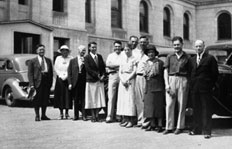Dr. Malcolm Ross Bow, 1887-1982

Promoting public health during hard times
Serving as Alberta’s Deputy Minister of Health throughout the Depression, Dr. Malcolm Bow’s support for public health did not change despite hard times in the province.
In the 1930s, Dr. Bow worked with a commission on health care proposals that later became the foundation for a national public health care program. He believed that “Public health is purchasable … The health of the people is a matter of vital concern to the state.”
Building Alberta's health care system
During Dr. Bow’s time as Deputy Minister of Health from 1927 to 1952, Alberta’s health care system became recognized as one of the most progressive in Canada. His focus was on preventing illnesses, especially infectious illnesses.
A master at analyzing health information, Dr. Bow thought that one-half of the preventable illnesses in Canada could be eradicated by vaccination. He believed that this process could save 23 million days in lost work time or $150 million per year in Canada.
Even during the Depression, he never lost government support for his public-health strategy (i.e., to maintain a healthy workforce) from the United Farmers of Alberta government or the post-1935 Social Credit government.
Among his many achievements, Dr. Bow appointed salaried provincial doctors to work in the remote areas of Northern Alberta. The first set were all female physicians, including Drs. Owen, Strang, Johnson and Percy (later Jackson).
During the polio outbreak of 1927, Dr. Bow had a hospital built as part of the University of Alberta Hospital to treat the survivors. During the second epidemic in 1938, he drafted the Polio Sufferers Act, which provided free rehabilitation services to all polio patients – a Canadian first.
He expanded the District Health Nursing programs, which began with four nurses in 1919. By 1939, there were 25 nurses. He also broadened the program’s services by starting the Rural Maternity and Well Baby programs.
Promoting public health insurance
From 1932 to 1934, he worked with the Hoadley Commission, to draft proposals for a health insurance program that would provide “adequate medical and health services for the people of Alberta.” He believed that government had a responsibility to pay for health care for those who could not afford it.
The Commission’s recommendations were enshrined in the 1935 Alberta Health Insurance Act, an act that died with the defeat of the UFA government that year.
The Commission’s proposals were supported by the Social Credit government, the Canadian Medical Association and later by the Federal government in their postwar health insurance proposal. The proposals became the foundation for the Canada Medical Care Act or Medicare in 1968.
Get the whole story!
|
 Read the full profile of Dr. Bow in Dr. Robert Lampard's "Alberta's Medical History"
Read the full profile of Dr. Bow in Dr. Robert Lampard's "Alberta's Medical History"